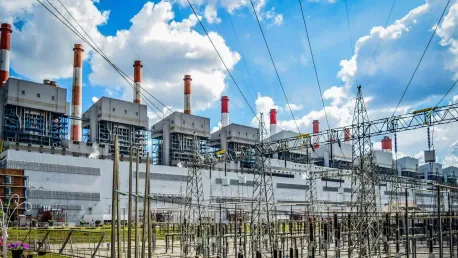The tumultuous landscape of the American power sector was laid bare before Congress during a recent House Energy Subcommittee hearing, revealing the escalating challenges posed by an unprecedented surge in demand for reliable electricity. The hearing, titled “Scaling for Growth: Meeting Demand for Reliable, Affordable Electricity,” took place on March 5 and featured industry leaders from PJM Interconnection, Basin Electric Power Cooperative, Southern Co., and Duke University. These experts dissected the nation’s power infrastructure, discussing both warnings and solutions to propel the sector forward amidst incoming hurdles.
Escalating Electricity Demand
The central issue of concern at the hearing was the surging electricity demand, primarily attributed to the rapid expansion of artificial intelligence (AI) data centers, a resurgence in U.S. manufacturing, and widespread electrification. Tyler Norris, a James B. Duke Fellow at Duke University’s Nicholas School of the Environment, emphasized the substantial contribution of AI-driven data centers to this demand surge, noting that these centers could add up to 65 gigawatts (GW) by 2029, representing 44% of America’s electricity growth over the forthcoming decade. This projection underscores the magnitude of the challenge facing the power sector as it grapples with meeting the growing energy needs of an increasingly digital and electrified world.
In addition to the rise in AI data centers, the manufacturing resurgence within the United States and broader electrification efforts contribute significantly to the escalating demand. This multifaceted growth necessitates a comprehensive and adaptive approach to expanding the power infrastructure. Grid operators and policymakers must navigate these intersecting trends and address them with innovative solutions to ensure the reliability, affordability, and sustainability of the electricity supply.
Industry Predictions
PJM Interconnection, the largest grid operator in North America, provided additional insights into the projected demand increases. Through its senior vice president of Governmental and Member Services, Asim Haque, PJM revealed their 2025 Long-Term Load Forecast, which predicts a significant increment in summer peak electricity demand. The forecast envisages a 70,000-megawatt (MW) increase over the next 15 years, a remarkable comparison to the record peak of 165,563 MW experienced in 2006. This substantial growth underscores the urgent need for strategic planning and robust infrastructure to accommodate the rising demands of the power sector.
Despite the promising growth prospects, existing barriers threaten to hinder capacity augmentation. Industry leaders highlighted challenges such as permitting and interconnection delays that complicate the development of new electricity generation capabilities. These hurdles, coupled with deep political and policy differences, emphasize the necessity of collaborative efforts and streamlined processes to ensure the sector’s ability to meet the projected demand effectively. The hearing underscored the importance of timely and efficient actions to navigate these challenges and leverage the growth opportunities while maintaining grid reliability and resilience.
Challenges to Expansion
The path to expanding the power sector is riddled with several key barriers that impede the smooth augmentation of capacity, including permitting and interconnection delays. These issues not only hamper the development of new electricity generation capabilities but also unveil deep political and policy differences that complicate effective solutions. Witnesses at the hearing expressed significant concerns about the retirement of dispatchable power generators, which are essential for maintaining grid stability due to their ability to respond promptly to operational directions. This phasing out, driven by state and federal policies promoting a transition toward renewable energy sources, adds a layer of complexity to grid management.
The imbalance between phasing out old capacities and adding new ones was vividly highlighted by PJM’s troubling statistics—only 4,800 MW were interconnected last year, against a system base clocking at 180,000 MW. This stark discrepancy underscores the need for a more streamlined and cohesive approach to interconnection and permitting processes. The hearing also revealed the partisan divides on how best to tackle these challenges efficiently, with lawmakers and industry leaders presenting divergent views on the optimal path forward. The urgency to resolve these bottlenecks is crucial for ensuring that the power sector can meet the growing demand without compromising reliability or stability.
Supply Chain Strain
Further exacerbating the challenges faced by the power sector is a tight supply chain for essential components such as gas turbines and transformers. Project financing is thrust into precarious limelight amidst these component shortages, complicating the timely completion of crucial projects. Todd Brickhouse, CEO of Basin Electric Power Cooperative, spotlighted the “regulatory red tape” particularly tied to the permitting obligations under the National Environmental Policy Act (NEPA). The Roundup-to-Kummer Ridge transmission project was cited as a poignant example of how regulatory hurdles can delay vital infrastructure developments necessary for meeting escalating energy demands.
The strain on the supply chain underscores the importance of addressing both regulatory and logistical challenges to ensure the seamless execution of power projects. Brickhouse’s testimony points to the need for balanced regulatory frameworks that facilitate rather than hinder the expansion of essential infrastructure. These considerations are critical as the power sector navigates the dual pressures of surging demand and supply chain constraints, both of which are pivotal to achieving reliable and sustainable electricity supply for the future.
Regulatory Impacts
A major topic of contention during the hearing was the impact of the U.S. Environmental Protection Agency’s (EPA) Power Plant Rule, finalized in May 2024, which has faced criticism for potentially stalling the development of new power plants due to stringent emissions limitations. The rule mandates that gas-fired plants capture 90% of their carbon emissions—a technological feat that is currently unproven at a commercial scale—or operate under severe output curtailments. This regulatory requirement injects significant uncertainty into future planning for power generation, as highlighted by industry leaders.
Brickhouse warned that compliance with such stringent regulations could have profound financial implications, necessitating nearly $10 billion in extra expenditures. Coupled with the projected $12 billion required for load growth by 2035, these costs signify a potential 60% rate increment for Basin Electric members. The plea extended to Congress was for an immediate repeal of the Power Plant Rule and relief measures for electric cooperatives. Additionally, there was a call for reforms in EPA’s New Source Review permitting regime to streamline processes and reduce barriers to new power plant development. These issues highlight the complex interplay between regulatory policies and the practicalities of expanding power infrastructure to meet growing demands.
Financial Implications
The financial implications of regulatory compliance and projected load growth are significant, as evidenced by the nearly $10 billion in extra expenditures highlighted by Brickhouse during the hearing. This comes on top of the already substantial $12 billion required to meet the projected load growth by 2035. These cumulative costs pose a potential 60% rate increment for Basin Electric members, reflecting the financial strain on cooperatives and ultimately on consumers. The financial burdens underscore the critical need for effective and balanced regulatory frameworks that support the growth and stability of the power sector without imposing undue costs on stakeholders.
The hearing extended a plea to Congress for immediate action, specifically calling for the repeal of the Power Plant Rule and compliance relief measures for electric cooperatives. Furthermore, industry leaders urged reforms in the EPA’s New Source Review permitting regime to facilitate smoother and more efficient processes for developing new power plants. These recommendations are vital for mitigating the financial pressures faced by power sector entities and ensuring the sustainable and cost-effective expansion of electricity generation capabilities to meet the burgeoning demand.
Infrastructure Necessities
A significant area of concern discussed during the hearing was the insufficiency of natural gas pipeline infrastructure. Brickhouse projected a triple increase in Basin Electric’s natural gas needs from 2024 to 2030, underscoring the importance of synchronized efforts between the electric and gas sectors to avoid service disruptions. The need to expand gas infrastructure is critical for meeting demand sustainably and reliably. Noel Black, senior vice president of Regulatory Affairs at Southern Co., concurred with the necessity of augmenting gas infrastructure, emphasizing its crucial role in supporting regional energy strategies and accommodating both scaling demands and broader electrification efforts.
The testimonies highlighted the urgency of addressing these infrastructure needs, particularly given the dynamic growth in sectors such as cryptocurrency mining and data centers. These technological loads can become operational within a relatively short span of three years, a stark contrast to the seven years needed for erecting dispatchable generation support. Federal assistance, particularly from the Department of Energy (DOE), was identified as critical in resolving transformer shortages and other supply chain issues, including financial backing for domestic manufacturing of vital grid components. Support for proactive infrastructure development was deemed essential to meet the rising energy demands and ensure a resilient and efficient power grid.
Flexible Load Management
Adapting existing infrastructure and leveraging flexible load management emerged as a promising solution to address immediate challenges. Tyler Norris from Duke University emphasized the optimized use of present facilities, promoting a strategic policy environment and proactive planning and investment in long-term resources. He underscored that larger electricity consumers can significantly mitigate peak demand pressures with minimal operational adjustments, which would ease the load on existing systems and enhance overall grid stability.
Norris’s forward-looking perspective calls for treating flexible loads as assets rather than liabilities. By adopting demand-side flexibility, data centers and industrial loads can play a pivotal role in stabilizing the grid, enabling the seamless induction of new loads without necessitating extensive and immediate infrastructure buildouts. This approach contrasts sharply with the inclination to significantly augment natural gas capacity, presenting a critical balance between addressing immediate load growth and fostering long-term investments in clean firm technologies. Moreover, Norris warned of potential market instability and increased gas price risks that could result from hasty expansions of natural gas capacities, advocating instead for a more measured and adaptable strategy.
Synchronized Efforts and Innovations
Forward-thinking initiatives, such as the Electric Power Research Institute (EPRI)’s DCFlex Initiative, are being explored to incorporate demand-side flexibility effectively. This project targets collaborations with power companies and high-energy consumer tech giants to proactively accommodate rising peak demands, encouraging the establishment of flexible data centers as tentative resources to manage grid strains. These innovative approaches highlight the potential for multi-stakeholder collaborations to harness the surge in electricity demands and streamline U.S. power grid operations.
The hearing encapsulated diverse viewpoints from Congressional lawmakers split along partisan lines. While Republican representatives advocated for bolstering baseload generation through increased coal, gas, and nuclear power to ensure grid reliability and energy security, Democratic lawmakers pressed for clean energy advancements. They asserted that renewable energy investments, supported by the Inflation Reduction Act (IRA), would be the swiftest and most economically viable intervention to meet the burgeoning demand. This discourse revealed the intricate balance required between addressing immediate energy needs and investing in sustainable future technologies. The testimonies underscored the critical importance of innovation and collaboration in navigating the complex landscape of the U.S. power sector.
Path Forward
The complex landscape of the American power sector was thoroughly examined during a recent House Energy Subcommittee hearing, highlighting the mounting challenges that come with a rapid rise in demand for dependable electricity. Held on March 5, the hearing was aptly titled “Scaling for Growth: Meeting Demand for Reliable, Affordable Electricity.” It brought together industry leaders from key organizations such as PJM Interconnection, Basin Electric Power Cooperative, Southern Co., and Duke University. These experts delved into the crucial aspects of the nation’s power infrastructure, offering a comprehensive analysis of current issues and potential solutions aimed at advancing the sector. The discussion emphasized the urgent need to address the escalating electricity demand while maintaining affordability and reliability. This critical discourse provided valuable insights into how the energy sector can adapt and thrive amidst the rising challenges.









